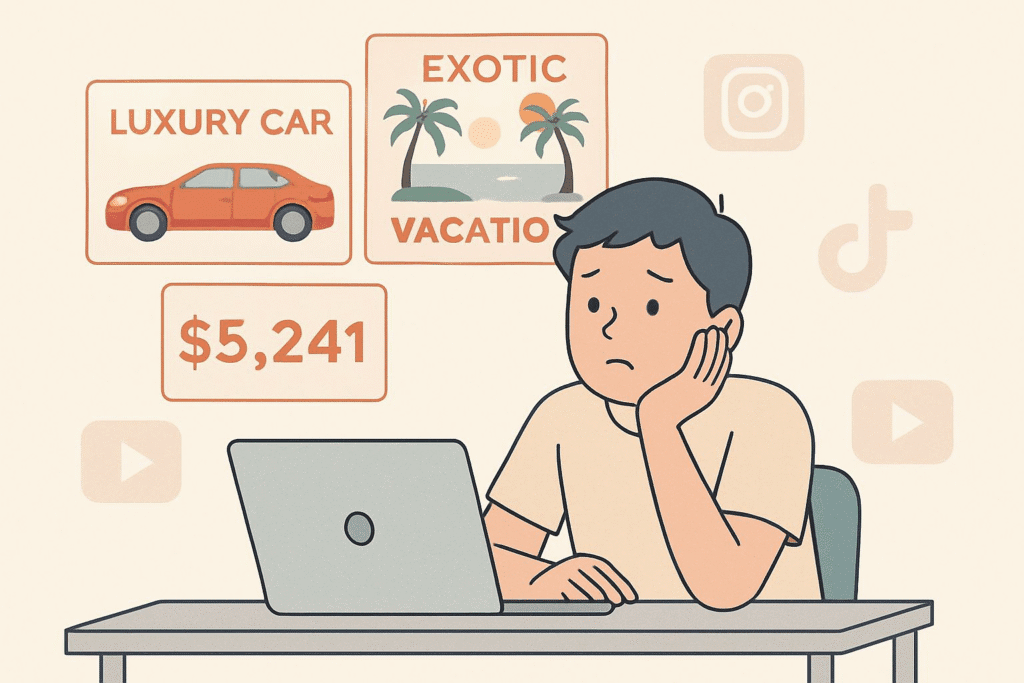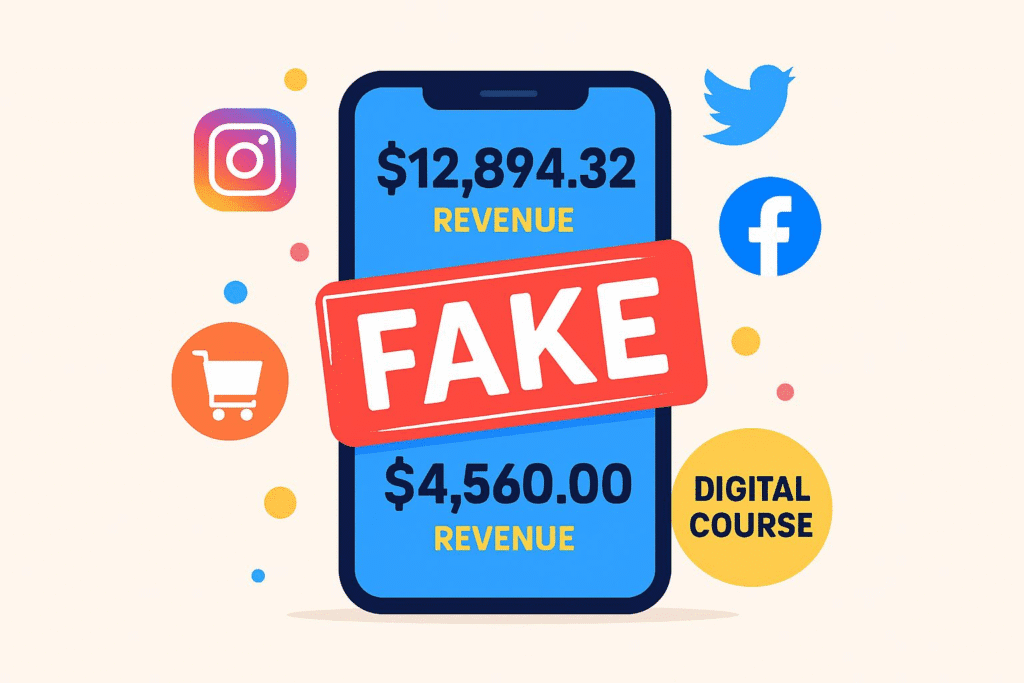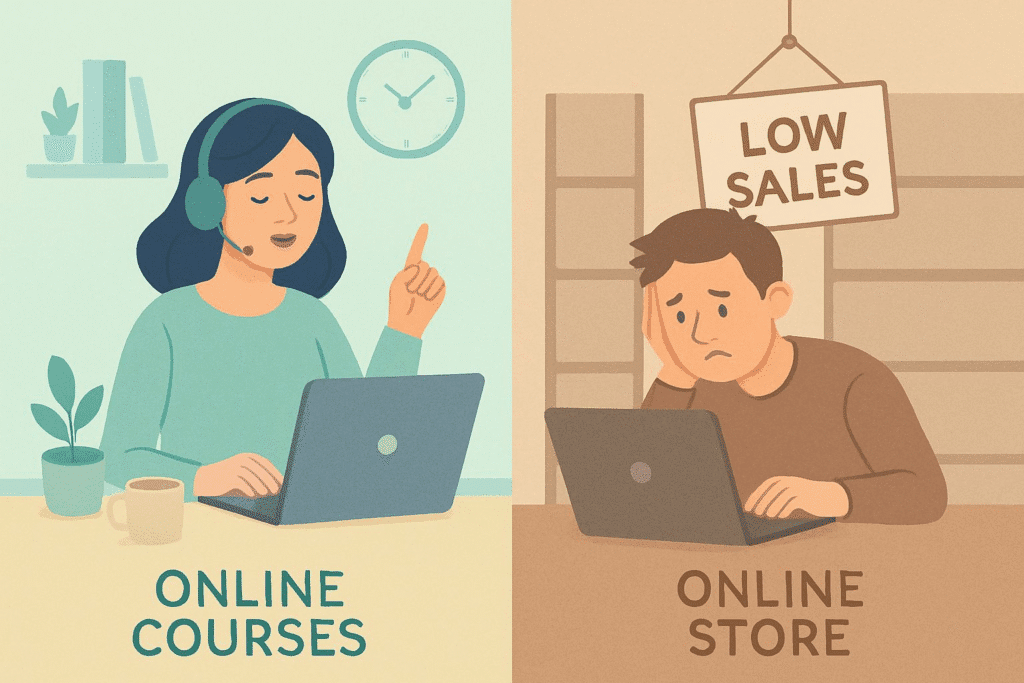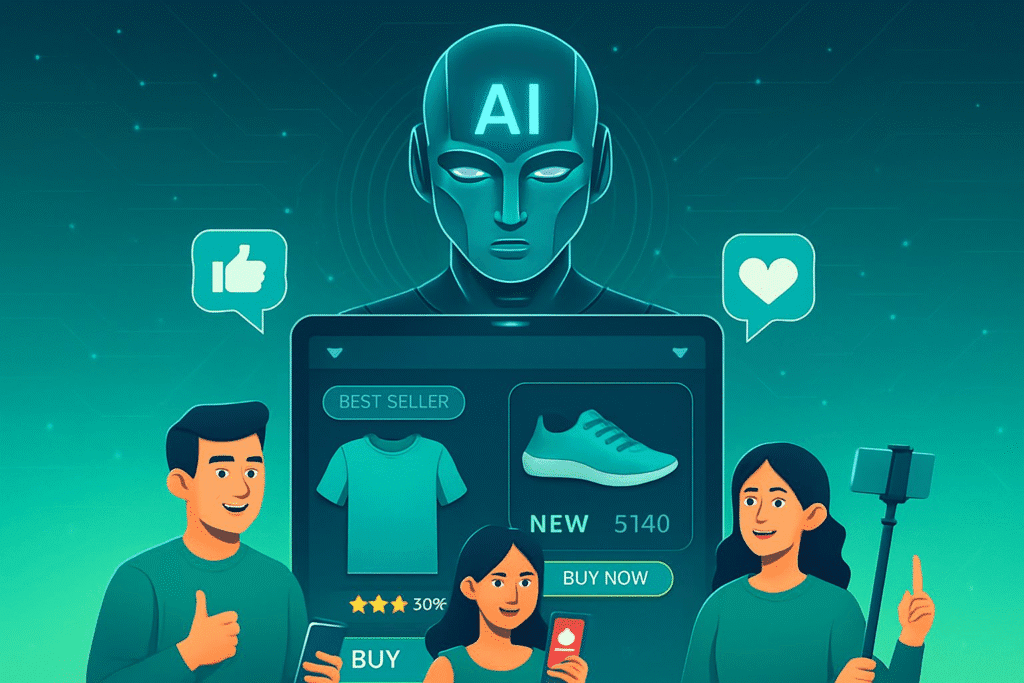Introduction

For years, dropshipping has been paraded as the golden gateway to passive income — an effortless way to earn six figures while sipping cocktails on a Bali beach. Scroll through Instagram or YouTube, and you’ll see countless ads showing rented Lamborghinis, fake Shopify dashboards, and smiling “entrepreneurs” who claim to have cracked the e-commerce code with zero experience and just a laptop.
But behind the smoke and mirrors lies a harsher truth.
Most aspiring dropshippers don’t make it past the first few months. And those influencers peddling success? Many of them haven’t earned a dime from a real store — their real hustle is selling the dream through overpriced online courses.
The dropshipping model isn’t a scam, but the way it’s being sold to the masses is dangerously misleading. Beneath the hype are razor-thin margins, fierce competition, customer service nightmares, and rising ad costs that quietly crush beginners before they see their first real profit.
This blog pulls back the curtain on the dropshipping illusion. You’ll discover:
- Why the business is far from “passive”
- How most gurus manipulate success stories
- What beginners aren’t being told about the risks
If you’re considering getting into dropshipping — or already feel stuck — this is the reality check you didn’t know you needed.
How Social Media Created the Myth of the Dropshipping Guru

What started as a niche e-commerce strategy quietly grew into a global obsession — not because of the business model itself, but because of how it was marketed. The real boom wasn’t in dropshipping success stories, but in a new breed of influencers: the self-declared “e-commerce gurus.”
Armed with slick editing, rented sports cars, and a phone full of doctored screenshots, these so-called experts took over platforms like YouTube, Instagram, and TikTok — selling not products, but a lifestyle fantasy.
The Social Media Illusion Machine
Here’s how they pulled it off:
- Luxury for Likes: Flashy Lamborghinis, penthouse apartments, and poolside selfies were all part of the performance — designed to create the illusion of effortless wealth.
- Fake Revenue Proof: Many used inspect-element browser tricks to show inflated Shopify dashboards or PayPal earnings, baiting viewers into believing they’d cracked some secret formula.
- Outrageous Promises: Claims like “$10,000 in one week as a beginner” or “Zero to six figures in 30 days” created unrealistic expectations and lured thousands into a model they barely understood.
While these tactics may have generated likes and followers, they also built a dangerously misleading narrative around dropshipping — one that cost many aspiring entrepreneurs more than just their time.
The Harsh Reality: Why Most E-Commerce Gurus Are Broke (and You Might Be Too)
Here’s what they don’t show you:
- Their “stores” barely break even or lose money entirely.
- Ad costs keep rising, making profit margins razor-thin.
- Saturation is real — everyone is selling the same trending products.
- Most “success stories” vanish within months as platforms crack down or trends die.
Meanwhile, the real winners? Facebook, Google, AliExpress suppliers, and course platforms — the backbone of the entire ecosystem.
The dropshipping guru phenomenon is built on exaggeration, hype, and cherry-picked wins. And behind every $10K earnings screenshot is often $9.5K spent on ads and refunds — something they rarely disclose.
The dream of passive income through dropshipping didn’t explode because of its business fundamentals — it exploded because of its marketability. And the ones who profited most weren’t product sellers. They were storytellers.
The Harsh Reality of Dropshipping: What No One Tells You

For all the flashy marketing and overnight success claims, dropshipping as a business model is a far cry from the passive income dream it’s made out to be. Behind the polished videos and course sales lies a much more demanding, often frustrating reality — one that’s rarely discussed until it’s too late.
Let’s break down what really happens when you dive into dropshipping with expectations built on hype.
1. Razor-Thin Margins: The Silent Killer
On paper, dropshipping seems affordable — no inventory, no warehousing, no upfront product costs. But in practice, profits are often eroded by a dozen hidden drains:
- Inflated product costs: Since you’re buying items one-by-one from third-party suppliers (often overseas), there’s virtually no volume discount. You’re paying retail-like prices and trying to sell at a markup that barely exists.
- Ad spending spirals: Facebook, Google, TikTok — customer acquisition has never been more expensive. Without a deep understanding of ad platforms, you’ll spend more than you make trying to get a single sale.
- Surprise deductions: Payment processing fees, refunds, chargebacks, and sometimes platform commissions quietly eat away at your revenue with every transaction.
The result? Many dropshippers find themselves pouring in money just to stay afloat — and even breaking even can feel like a win.
2. Oversaturation and Ruthless Competition
One of dropshipping’s biggest strengths — low entry barriers — is also its biggest weakness.
Because it’s so easy to start, the market is flooded with copycat stores selling the exact same products. And when thousands of sellers push the same trending gadget or beauty tool, it quickly becomes a race to the bottom:
- No uniqueness: Most stores look and feel identical. If you’re not branding or adding value, you’re invisible.
- Price wars: Competitors slash prices to win sales, which cuts already-thin margins to nearly zero.
- Big players dominate: Why would a customer wait three weeks and pay more when Amazon can ship the same product tomorrow for less?
Without a clear niche, strong branding, or a unique selling proposition, your store becomes just another face in a very crowded crowd.
3. Customer Service Chaos
Since dropshipping stores don’t control inventory, shipping, or product quality, they’re at the mercy of third-party suppliers — and that’s where things often fall apart.
- Slow shipping: Standard delivery times can range from 10 to 30 days, which frustrates customers used to Amazon Prime speed.
- Unreliable quality: Suppliers cut corners, send defective products, or switch inventory without notice — and your store takes the hit.
- Return headaches: Handling complaints, refunds, and chargebacks becomes a full-time job, often without tools or support to manage it properly.
These issues not only hurt your reputation but also make it incredibly hard to retain customers. Many one-time buyers never return, leaving store owners stuck in an expensive cycle of always chasing new traffic.
4. The Smoke and Mirrors of Success Stories
The final blow? Much of the so-called inspiration in the dropshipping space is built on half-truths, exaggerations, or outright lies.
- Manipulated revenue screenshots: It’s shockingly easy to fake Shopify dashboards or edit PayPal earnings. Some “gurus” haven’t sold a product in months — but their course sales keep rolling in.
- Selective storytelling: For every rags-to-riches video, there are hundreds of stories of people who failed, burned out, or quit — but you’ll never hear about them.
- The “passive” myth: Dropshipping is sold as hands-off income, but in reality, it requires constant ad testing, supplier coordination, customer service, and platform compliance.
Aspiring entrepreneurs walk into this world expecting freedom. What they often get instead is a high-maintenance, low-reward hustle that leaves them overworked and underpaid.
Why Most E-Commerce Gurus Are Broke (Even If They Don’t Look Like It)

Scroll through Instagram or YouTube, and you’ll find a parade of self-proclaimed e-commerce experts flaunting rented Lamborghinis, luxury vacations, and six-figure dashboards. They speak in absolutes — “Anyone can do this,” “No skills needed,” “I made $100K last month.” But behind the scenes, many of these so-called gurus are flat broke or barely breaking even.
Why? Because their real business isn’t dropshipping. It’s selling the idea of dropshipping to people desperate for a shortcut to success.
1. The Real Money Isn’t in Stores — It’s in Selling Courses
Here’s the dirty little secret of the e-commerce education space: the vast majority of these “experts” don’t make real money from their stores. In fact, most abandon their actual businesses as soon as their personal brand starts gaining traction.
Why? Because it’s far more profitable and easier to sell a dream than to build a working store.
- Courses offer guaranteed income without the volatility of ad costs, supplier delays, or customer complaints.
- New entrepreneurs, lured by flashy success stories, will pay hundreds — sometimes thousands — for access to “insider secrets.”
- The course business is infinitely scalable. One winning sales funnel can be milked for years.
Instead of testing products, optimizing stores, or handling customers, these gurus shift focus entirely to marketing themselves — trading substance for influence, and real business for perceived authority.
2. Dropshipping Isn’t Built to Last
Even the dropshippers who do achieve short-term wins face a ticking clock. Profitability in this model is notoriously fragile, and it’s getting worse by the year.
- Ad platforms are ruthless. Facebook and Google have become pay-to-play ecosystems where customer acquisition costs can skyrocket overnight.
- Quality control is a gamble. With many suppliers based overseas, delivery delays and defective products lead to refund requests, chargebacks, and negative reviews that kill repeat business.
- Everyone’s selling the same thing. Without strong branding or a unique angle, you’re one of thousands trying to win the same customer — usually by cutting your own margins.
For most, success is short-lived. They might find a winning product and scale it for a few months, but when the trend dies or the ad account gets banned, the entire operation collapses. There’s no foundation — just a cycle of launch, burn out, and start over.
3. Success Stories Are Often Built on Lies
To keep the funnel full of eager students, gurus must constantly showcase success — even when there isn’t any. That’s where manipulation comes in.
- Screenshots are faked or edited with browser tools like “Inspect Element” to show inflated Shopify or PayPal figures.
- Only the wins are shared. They highlight one lucky student who got results, while ignoring the 99 others who failed or never launched a store.
- The whole “passive income” pitch is misleading. Real dropshipping requires constant monitoring — from tweaking ad creatives to managing suppliers and handling angry customers.
The truth is, many of these gurus are more skilled at marketing themselves than running businesses. They’ve built empires on hype, not on honest results — and the people who suffer are the hopeful entrepreneurs who buy in without knowing what they’re truly signing up for.
What Actually Works in E-Commerce: Moving Beyond Dropshipping

While dropshipping has been painted as the ultimate shortcut to online wealth, its shortcomings have become painfully clear to many entrepreneurs. But don’t mistake the failure of dropshipping for the failure of e-commerce itself. In fact, e-commerce continues to be one of the fastest-growing industries worldwide — the secret lies in building a real brand, choosing smarter business models, and embracing new technology.
Let’s explore what genuinely works in today’s online retail landscape.
Building a Real Brand: The Foundation of Lasting Success
The difference between a fleeting dropshipping store and a thriving e-commerce business is branding. Instead of simply reselling generic products sourced from far-off suppliers, successful entrepreneurs focus on creating an identity that customers recognize and trust.
This means investing in private labeling — designing your own products or packaging that stand apart from the sea of lookalikes. It means prioritizing quality and customer experience over quick wins. When shoppers associate your brand with reliability, style, or innovation, they keep coming back — building loyalty that’s impossible to buy with ads alone.
Brand-building isn’t just about logos or slogans; it’s about crafting a story and delivering consistent value that turns one-time buyers into lifelong fans.
Exploring Alternative Business Models That Deliver Better Results
Dropshipping is just one way to sell online — and often the least sustainable. Fortunately, there are more robust models that combine profitability with customer satisfaction:
- Print-on-demand allows you to create unique, customized products with minimal inventory risk while commanding healthier profit margins.
- Subscription-based e-commerce creates predictable, recurring revenue by offering customers convenience and exclusivity, from curated boxes to replenishable essentials.
- Wholesale and direct sourcing empower sellers to cut out middlemen, negotiate better prices, and control product quality — a recipe for sustainable growth.
Each of these models reduces reliance on paid ads, improves margins, and enhances the overall shopping experience, making them smarter alternatives to traditional dropshipping.
The Future of E-Commerce: Technology and Sustainability Take Center Stage

The e-commerce landscape is evolving fast, and tomorrow’s winners will be those who embrace innovation and responsibility.
Artificial intelligence is transforming how businesses select products, target customers, and optimize marketing campaigns — automating tasks that once required hours of manual effort.
Meanwhile, influencer-driven brands are reshaping customer relationships by leveraging social proof and authentic engagement on social platforms. This trend is moving e-commerce away from faceless stores and toward communities built on trust and shared values.
Finally, sustainability is no longer optional. Consumers increasingly demand ethical sourcing, eco-friendly packaging, and transparent practices. Brands that embed sustainability into their business models won’t just survive — they’ll thrive.
Conclusion
The dropshipping delusion has lured thousands of hopeful entrepreneurs into believing a get-rich-quick fantasy that rarely delivers real results. While flashy gurus flaunt luxury lifestyles and six-figure screenshots, the reality is far less glamorous — most dropshippers grapple with razor-thin profit margins, fierce competition, and misleading narratives.
Here’s the hard truth:
✅ Most e-commerce gurus earn from selling courses, not from running actual stores.
✅ Dropshipping profits are unsustainable due to high ad costs and market saturation.
✅ Customer service challenges, long shipping times, and high refund rates undermine reliability.
✅ The true beneficiaries are ad platforms, payment processors, and suppliers—not the store owners.
Instead of chasing these myths, aspiring entrepreneurs should focus on building authentic brands, exploring alternative e-commerce models, and leveraging AI-driven automation for sustainable growth.
For deeper insights and more valuable content, explore other blogs on InkInsight.in.
FAQ’s
Is dropshipping dead?
Dropshipping isn’t completely dead, but the market is oversaturated and highly competitive, making it challenging for new sellers to achieve success.
How much do dropshippers actually make?
While some experienced dropshippers can earn $100,000+ per year, many struggle to break even due to high advertising costs, supplier fees, and refund rates.
Why do most dropshipping businesses fail?
Dropshipping ventures often fail because of low profit margins, intense competition, poor customer service, and unrealistic expectations fueled by gurus.
Can dropshipping make me rich in 2025?
It’s possible, but success requires considerable time, effort, and strategic planning. Most gurus tend to overpromise results, making the process seem easier than it truly is.
What are better alternatives to dropshipping?
More sustainable e-commerce models include private labeling, print-on-demand, subscription-based businesses, and wholesale sourcing, which typically offer higher profit margins and improved customer satisfaction.
